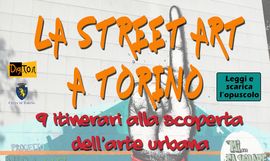Home » DISCOVERING TURIN » Guide to urban art: San Salvario
31 Ottobre 2019
Guide to urban art: San Salvario
Our journey to discover Turin’s districts art continues with paintings of polar bears, faces made on plaster with chisels and works related to the environment
Carlotta Bianchini (translation by Giulia Schimmenti)

The mural “Black Machine” by Nevercrew
After the previous tours in the neighborhoods of Santa Rita and Mirafiori Nord, Barriera di Milano and Mirafiori Sud, our next destination in search of street art will be San Salvario, also depicted in the photos of Carlotta Bianchini.
Starting point: via Giacosa 8. At the corner with via Saluzzo we can see the work I Giocolieri, by Mario Molinari, painted on the facade of the building by his son Jacopo in 2012. Through elements such as wheels and horses, it represents “movement” and life to be shared with others.
Turning onto via Belfiore and looking up at number 40, we see Blu Cerebrale, created in 2015 by writer Corn 79 on the walls of the building: a gigantic sphere that gives the impression of causing, on the blue surface, an effect of movement of the waves. We continue towards the Regina Margherita high school in via Valperga Caluso 12, whose wall, painted in 2015 by the association Il Cerchio e le Gocce together with the students of the institute, has a large mural that recalls the works of the Bauhaus of the early twentieth century.
Passing through the back of the building and going in the direction of via Madama Cristina, we get to Teatro Colosseo, which shows under the banner the three-dimensional work of artist Peeta and, on the side facade overlooking via Bidone, a set of overlapping works. One cannot help but notice The Big Bear, an art work by Portuguese artist Bordalo II. The huge bear was made by assembling waste such as a dumpster, a bicycle frame and metal sheets to create a “big trash animal” about 8 meters high. The work is intended to be an environmental message, a tribute to the memory of the bear Daniza killed in Trentino in 2014, but also a criticism to consumerism, whose waste threatens nature. On the side we see Black Dream Wall, a wall that collects the thoughts and desires of passers-by, written with chalk.
Above it, City Circle by Dutch artist Zedz, who, with a nail and a cord, has drawn on the surface, including balconies and windows, a large circle of ten meters in diameter, painted by hand. The drawing represents a schematic plan of the neighborhood.
In the inner courtyard of Colosseo we find Black Machine by the Swiss duo Nevercrew, a large polar bear swimming in a sea of oil, to underline the effects of global warming. This work is very important for Italian street art as it was the first project to combine urban art and augmented reality. Black Machine can also be used through the Bepart app.

One of the murals in corso Bramante
Turning left onto via Ormea, on the wall of the Clinica Sedes Sapientiae, the Duel mural by Etn!k (also accessible through Bepart) represents the conflict between city and nature, which takes up its spaces and sprouts between one building and another.
We now move to corso Massimo d’Azeglio. At number 76 we find Figure col Sole, a sculpture by Franco Garelli conceived as a fountain and made with ferrous industrial waste assembled in such a way as to create a cloud and a sun.
Deviating on via Petrarca we reach via Nizza 50 where we find, on the blind facade of a building, the face of a man made with the chisel of Portuguese Vhils. He is an ordinary man, photographed by the same author during one of his travels.
Along via Argentero we arrive in via Lugaro. In the parking lot of La Stampa we can see an imposing mural entitled AbitHoudini, created by Agostino Iacurci, an artist from Puglia who, working on the concepts of reality and illusion, wanted to propose some scenes from the daily life of a magician: glimpses of the interior and exterior of the house of a person who in life builds illusions to the point of getting used to tricks and bring them into his life with total indifference.
Turning into corso Dante, on the left we find ourselves in the Luigi Firpo garden, where we can see two murals, one by Ride and one by Weed; descending from via Grossi and turning into via Benvenuto Cellini, at number 11 we come across Xel‘s work entitled Omaggio a Georges Braque.
We continue in the direction of corso Bramante and descend along the spans of the flyover to observe a long mural made by different artists in the context of Pic Turin 2010 and with the later-on intervention in 2018 by many others.
As the last art work of the tour, we find Dal Vecchio al Nuovo, located at the intersection of corso Bramante and Corso Massimo d’Azeglio, near ponte Franco Balbis. The work, which won the 1994 Umberto Mastroianni Sculpture Prize, consists of a high stone parallelepiped on top of which is placed a steel sphere on which, in a falsely precarious balance, is placed a rusted iron case from which solidified tar flows. It is a symbolic work, where the “old” is represented by the monolith, while the “new” is represented by the iron case placed in a precarious balance.
In collaboration with Study in Torino
Thank you to the art historian Marzia Bolle for her consulting





